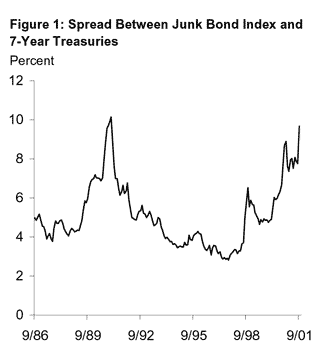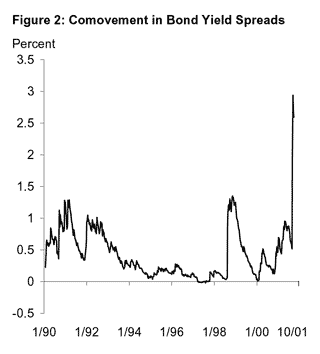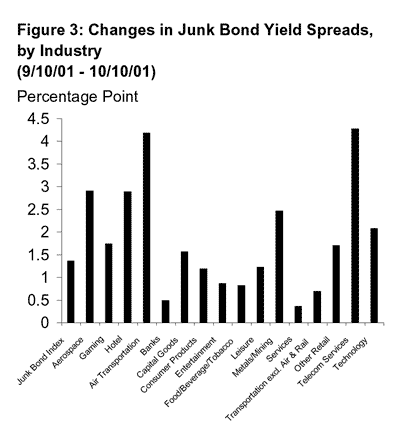Economists and other analysts look for signs of the economy’s current and future performance in many places, including the bond market. One recent signal from that market that may prove useful involves the spread in the yields between junk bonds and other long-term debt instruments.
- Yield spreads of junk bonds
- The liquidity shock in 1998
- Putting recent movements into perspective
- Conclusion
- Reference
Economists and other analysts look for signs of the economy’s current and future performance in many places, including the bond market. One recent signal from that market that may prove useful involves the spread in the yields between junk bonds and other long-term debt instruments. For example, the Merrill Lynch junk bond index has reached its highest level since the last recession, while investment-grade bond yields remain fairly low by historical standards. Junk bonds, or speculative-grade bonds, are rated below Baa by Moody’s (and below BBB by Standard and Poor’s), the minimum rating for investment-grade bonds. Junk bonds also are called high-yield bonds because they carry significantly higher interest rates to compensate investors for bearing the higher risk that is inherent in those bonds. A widening in the spread between junk bonds and other long-term debt instruments may be a useful signal because junk bonds are issued by firms with marginal credit quality that are more vulnerable to changes in economic conditions than investment-grade borrowers. This Economic Letter takes a closer look at the recent increase in junk bond yields, and, in particular, compares the latest episode to the sharp rise in junk bond yields in 1998 following the Asian financial crises.
Like any fixed-income securities, the return from holding a junk bond is usually measured by the yield-to-maturity, which is the rate of return for holding a bond until maturity. The junk bond yield involves two components: the default-free bond yield and the risk premium. The default-free bond yield refers to the rate of return for holding a similar maturity default-free bond, which usually is represented by Treasury securities. The risk premium compensates the investor for bearing the credit risk and the liquidity risk of the junk bond. Credit risk refers to the possibility that the borrower will default. Liquidity risk refers to the potential liquidation cost from selling the bonds in a thin market. In a thin market where potential buyers are scarce, not only does the bid-ask spread on a security widen, but also sellers must lower the bond price both to lure buyers into the market and to compensate them for the heightened liquidity risk. While the market for Treasury securities is considered very deep and resilient, hence involving little liquidity risk, corporate bonds have liquidity risk because each bond issue is relatively small. Moreover, each corporate bond has unique attributes, so the number of ready buyers for each bond can be quite limited. Among corporate bonds, junk bonds have more liquidity risk because their issue sizes generally are relatively small compared to investment-grade issues. Moreover, many institutional investors, including pension funds and certain trust accounts, are prohibited from investing in below-investment-grade securities, further limiting the pool of potential investors.

To isolate the junk bond risk premium from pure interest rate movements, Figure 1 charts the yield spread between the Merrill Lynch junk bond index and 7-year constant maturity Treasuries since 1986. Although the available data span only one business cycle, the figure suggests that the junk bond risk premium rises and falls with the business cycle. Borrowers’ ability to service their debt obligations, particularly marginal borrowers, is usually higher during economic expansions than contractions. So, during expansions, credit risk tends to be lower and, hence, the yield spread tends to be narrower, while the reverse tends to hold during slowdowns. In Figure 1, the yield spread for junk bonds jumped 258 basis points from January 1989 to June 1990, just before the economy entered the recession. Thus, the run-up in the junk bond risk premium in 1989 and early 1990 was consistent with the rising credit risk concerns at that time.
Between June 1998 and October 1998, the junk bond risk premium rose 334 basis points, but no recession followed. Rather, the increase in risk spreads appears to have been tied to turmoil in financial markets. Around mid-1997, the Asian financial crisis began to unfold, culminating in the Russian government’s default on its sovereign debt in October 1998. This led to the seizing up of the credit market and the near collapse of the hedge fund, Long-Term Capital Management. At that time, the large degree of uncertainty in the credit market made it very difficult to liquidate risky bonds, as potential investors exited the corporate bond market in favor of the default-free Treasury market. It appeared that the lack of liquidity in the corporate bond market was the driving force behind the yield rise in 1998.
To see more clearly how a liquidity shock drives junk bond yields, it is useful to look at the comovement in bond yields. The comovement in bond yields should be high in response to a liquidity shock, because it is a systemic event that can be expected to have a similar qualitative effect (though different quantitative effect) on corporate bonds across the risk spectrum. In contrast, when changes in bond yields are driven by changes in the credit quality of the borrowers, the movements in bond yields would be expected to respond to the idiosyncratic shock of the borrowers, implying that the comovement in bond yields is expected to be lower.

To illustrate this, Figure 2 shows the covariance between the change in Moody’s Aaa rated-Treasury spread and the change in the junk bond-Treasury spread since 1990. During the 1990-1991 recession, the comovement in the Aaa-rated and junk bond yield spreads rose in response to general deterioration in the economy, but it took more than a year before the rising covariance peaked. In contrast, in 1998, the comovement in yield spreads rose sharply in August and peaked in just three months. This suggests that the movement in yield spreads in 1998 was consistent with a systemic event, namely, the lack of liquidity in the bond market.
Nevertheless, a systemic shock also may worsen the credit quality of many borrowers, leading to a widespread increase in credit risk premiums and thus a high level of comovement in risk spreads. To distinguish between liquidity shocks and credit risk shocks further, it may be useful to look at the relation between stock and bond prices. Absent changes in liquidity constraints, movements in bond yields reflect the bond market’s assessment of the borrower’s creditworthiness. Since many borrowers in the junk bond market also issue publicly traded stocks, the stock market also is continuously assessing the future prospect of the borrowing firm. Kwan (1996) shows that there is a strong relation between changes in the bond yield and the borrowing firm’s stock returns, particularly among junk bond borrowers, as both stock and bond prices generally are driven by the same firm-specific information.
In the case of a general liquidity shock, however, movement in risk spreads may be less tightly linked with firm-specific developments, as evidenced during the 1998 financial market turmoil. For example, consider the performance in four sectors: telecommunications, technology, energy, and health care. Between November 1997 and October 1998, the risk spread for junk bonds in telecom, technology, and health care sectors rose between 100% and 130%. Despite the similarity in the changes in bond yields, the stock price performance for these three sectors was quite different. The average annualized stock returns for junk bond issuers in telecom and technology were positive, at 17.8% and 131%, respectively, while those in health care were negative, at -55%. The energy sector saw the largest relative rise in junk bond spreads, at 233%, even though the issuers’ average stock return, at -30.5%, was higher than those in the health care sector.
The apparent disconnect between the pricing of the debt and equity of junk bond issuers during 1997-1998 suggests that the rise in junk bond risk spreads was not entirely driven by changes in firm-specific fundamentals. Rather, it was more consistent with a general shift in liquidity preference among investors.
Putting recent movements into perspective
Before the terrorist attacks on September 11, the yield spread of the Merrill Lynch junk bond index had risen more than 300 basis points since the beginning of 2000 (Figure 1). This was accompanied by a gradual increase in the comovement of bond yield spreads. These patterns seem to suggest that before the attacks, the run-up in junk bond spreads was driven by concerns about rising credit risk. However, following the attacks, the spread skyrocketed almost 200 basis points to 968 basis points, just 46 basis points shy of the peak recorded during the 1990-1991 recession. While there is no question that a large part of the rise in junk bond yields reflects investors’ reassessment of credit risk, the comovement in bond yield spreads, shown in Figure 2, shot up to a level not seen before. Both the rate of the increase and the level of comovement in yield spreads after September 11 indicate that some of the sizable jump in yield spreads may be attributable to the limited liquidity in the junk bond market.
Of the four sectors examined earlier, between January 2000 and August 2001, junk bond spreads in the energy sector had risen only 21% (or 100 basis points) while spreads in the health care sector had actually declined 15% (or 56 basis points). This reflects the positive developments in these two sectors, as evidenced by the 48% one-year return on energy stocks and the 70.5% return on the health care stocks of the junk bond borrowers. During that time, junk bond investors clearly were discriminating between good and poor performers as judged by the stock market. The junk bond spread rose 225% (1129 basis points) in the telecom sector and 116% (553 basis points) in the technology sector. The one-year stock returns of the junk bond borrowers in the telecom sector and the technology sector were -57.4% and -72.5%, respectively. This further suggests that the increase in junk bond yields before the attacks was driven by credit concerns about specific companies, most notably telecom firms and technology companies.

After the terrorist attacks, the widening of risk spreads on junk bonds was evident in most sectors, but especially among firms in the air travel and tourism industries. Figure 3 shows changes in risk spreads based on Merrill Lynch’s index for firms in 16 sectors with junk bonds outstanding, from September 10 to October 10, 2001. While investors are reassessing the credit risk of different borrowers in different sectors as a result of the attacks, the fact that all sectors among junk bond issuers show some increase in risk spreads suggests that a deterioration of liquidity in the junk bond market may have exacerbated borrowing costs.
Junk bonds provide financial market signals about current and future economic activity because their yields reflect the market’s assessment of the credit prospects of the borrowing firms, whose marginal credit quality is highly sensitive to changing economic conditions. However, in addition to credit concerns, junk bond yields also are driven by systemic factors, among which the level of liquidity in the bond market is perhaps the most important. In interpreting junk bond yields, it is necessary to separate the systemic factors from the idiosyncratic factors. Before September 11, the run-up in junk bond yields in 2001 seems to have reflected specific credit concerns about the borrowing firms, as firms whose stocks were performing well generally did not see their junk bond yields go up, and the comovement in bond yields was not that high. After September 11, the sharp rise in junk bond yields clearly reflects the heightened credit risk of the borrowers. At the same time, the comovement in bond yields spiked up to a level not seen before, suggesting that deteriorating liquidity in the junk bond market may have pushed borrowing costs up further.
Simon Kwan
Research Advisor
Kwan, S.H. 1996. “Firm-specific Information and the Correlation between Individual Stocks and Bonds.” Journal of Financial Economics 40, pp. 63-80.
Opinions expressed in FRBSF Economic Letter do not necessarily reflect the views of the management of the Federal Reserve Bank of San Francisco or of the Board of Governors of the Federal Reserve System. This publication is edited by Anita Todd and Karen Barnes. Permission to reprint portions of articles or whole articles must be obtained in writing. Please send editorial comments and requests for reprint permission to research.library@sf.frb.org